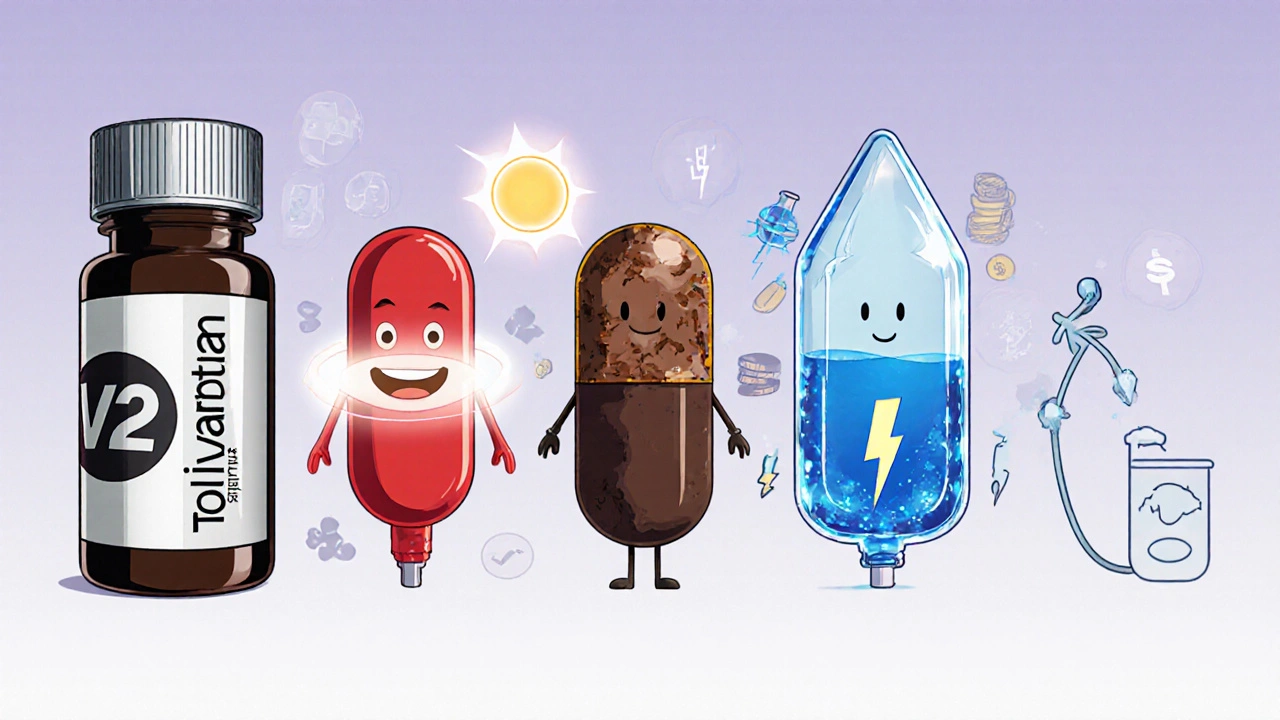Hyponatremia & ADPKD Treatment Decision Tool
Select Your Condition
When doctors talk about managing certain kidney conditions, Natrise (Tolvaptan) is a selective vasopressin V2‑receptor antagonist approved for slowing cyst growth in autosomal dominant polycystic kidney disease (ADPKD). It’s also used off‑label for treating euvolemic hyponatremia. If you’re weighing Tolvaptan against other options, you’ll want to compare how they work, how they’re given, side‑effects, costs, and how the FDA views them.
Key Takeaways
- Tolvaptan directly blocks the V2 receptor, making it the only oral drug that slows ADPKD progression.
- Alternatives such as conivaptan or demeclocycline work differently and are usually reserved for acute hyponatremia.
- Cost and monitoring requirements make Tolvaptan a high‑maintenance therapy.
- For mild hyponatremia, non‑pharmacologic measures like fluid restriction can be just as effective.
- Safety profiles vary: liver toxicity is a unique concern with Tolvaptan, while hypertonic saline risks rapid over‑correction.
How Tolvaptan Works - The Science Behind Natrise
As a vasopressin V2‑receptor antagonist, Tolvaptan binds to the V2 receptors in the collecting ducts of the kidney. By blocking vasopressin’s signal, the drug reduces water reabsorption, leading to increased free water excretion (aquaresis). This diuretic effect raises serum sodium and, in ADPKD, reduces intracellular cAMP that drives cyst expansion.
Major Alternatives - What Else Is on the Table?
Below are the most commonly referenced alternatives for the two main indications where Tolvaptan is used.
| Drug / Approach | Primary Indication | Mechanism | Typical Dose | Route | Key Side Effects | FDA Status | Approx. Annual Cost (USD) |
|---|---|---|---|---|---|---|---|
| Natrise (Tolvaptan) | ADPKD, euvolemic hyponatremia | V2‑receptor antagonism → aquaresis | 45‑120 mg/day split BID | Oral | Liver enzyme rise, thirst, polyuria | Approved (US, EU, AU) | $12,000‑$20,000 |
| Conivaptan | Acute euvolemic/hypervolemic hyponatremia | V1A/V2‑receptor antagonist (IV) | 20‑40 mg IV over 30 min, then 20 mg q12h | Intravenous | Hypotension, infusion‑site reactions | Approved (US) | $3,000‑$5,000 |
| Demeclocycline | Chronic hyponatremia (SIADH) | Inhibits renal tubular response to ADH | 300‑600 mg PO q12h | Oral | Nephrotoxicity, photosensitivity | Off‑label | $200‑$500 |
| Hypertonic Saline (3% NaCl) | Severe symptomatic hyponatremia | Directly raises serum Na⁺ | 100‑150 mL bolus, then 0.5‑1 mL/kg/hr | IV | Osmotic demyelination if over‑corrected | Approved (US) | $50‑$200 |
| Urea | Chronic hyponatremia (especially in heart failure) | Increases renal free water clearance | 15‑30 g PO q8h | Oral | GI upset, bad taste | Off‑label | $300‑$800 |
| Fluid Restriction | All types of hyponatremia | Reduces free water intake | 800‑1000 mL/day (patient‑specific) | Behavioral | Non‑compliance, thirst | Non‑pharmacologic | Free |

When to Choose Tolvaptan Over Others
If your doctor diagnosed ADPKD and your eGFR is above 30 mL/min/1.73 m², Tolvaptan is the only oral therapy that directly targets cyst growth. The benefits are clear: slower decline in kidney function and a delay in dialysis.
For hyponatremia, Tolvaptan shines when you need a long‑term, oral solution and when rapid correction isn’t required. It’s especially good for patients who can’t tolerate IV therapy or who need a chronic outpatient plan.
When an Alternative Might Fit Better
Conivaptan is IV‑only, so it’s ideal for hospitalised patients who need quick sodium correction. Demeclocycline works for chronic SIADH but carries a risk of kidney damage-so you’d avoid it if baseline renal function is already shaky.
In severe, symptomatic cases, hypertonic saline is the fastest way to raise sodium, but you must monitor closely to avoid osmotic demyelination. Urea and fluid restriction are cheap, low‑tech options that work well in heart‑failure‑related hyponatremia where the patient can adhere to a strict intake plan.
Safety Profile - What to Watch For
Liver Toxicity: Tolvaptan requires monthly liver‑function tests for the first 18 months because of documented cases of severe hepatitis. If enzymes rise >3× ULN, you’ll need to stop the drug.
Polyuria and Thirst: Because it forces the kidneys to dump water, patients often report needing to urinate every hour. Staying well‑hydrated (but not over‑drinking) is key.
Conivaptan can cause hypotension due to V1A blockade, so blood pressure monitoring is mandatory.
Demeclocycline carries a black‑box warning for permanent kidney damage, especially in older adults.
Hypertonic Saline must be infused under cardiac monitoring; over‑correction can lead to irreversible brain injury.

Cost and Access - The Real‑World Considerations
Tolvaptan’s price is the biggest hurdle. In the US and Australia, the drug can cost upwards of $15,000 a year for the ADPKD dose. Insurance coverage varies; many plans require prior authorization and evidence of rapid cyst growth.
Conivaptan, being IV, is cheaper per dose but adds hospital stay costs. Demeclocycline is inexpensive but often unavailable in the US due to supply issues.
Urea and fluid restriction cost virtually nothing, but they demand strict patient adherence, which can be challenging.
Practical Decision‑Making Checklist
- Identify the primary indication: ADPKD vs hyponatremia.
- Assess renal and liver function - Tolvaptan needs normal‑to‑moderate liver enzymes.
- Consider the setting: inpatient (IV drugs) vs outpatient (oral).
- Review cost‑budget and insurance coverage.
- Discuss patient preferences: willingness to handle frequent urination, monitoring visits, and potential side‑effects.
Bottom Line - Tailor the Choice to the Patient
There’s no one‑size‑fits‑all answer. If you have ADPKD and can handle monthly labs, Natrise (Tolvaptan) offers disease‑modifying benefits you won’t get from fluid restriction or demeclocycline. If you’re dealing with an acute hyponatremia crisis in the hospital, IV conivaptan or hypertonic saline will get you back on track faster. For chronic, mild hyponatremia where cost is a concern, urea or a disciplined fluid‑restriction plan may be the smartest move.
Can Tolvaptan be used for chronic hyponatremia?
Yes, Tolvaptan is FDA‑approved for euvolemic hyponatremia and is often prescribed when patients need a long‑term oral solution. Monitoring liver enzymes is mandatory.
What are the main side effects of Tolvaptan?
Common side effects include excessive thirst, increased urination, and elevated liver enzymes. Rarely, patients develop severe hepatitis, which is why monthly labs are required.
How does conivaptan differ from Tolvaptan?
Conivaptan blocks both V1A and V2 receptors and is given intravenously, making it suitable for acute, inpatient correction. Tolvaptan selectively blocks V2 and is taken orally for chronic management.
Is demeclocycline still a good option?
It can be used for chronic SIADH, but the risk of permanent kidney damage limits its use, especially in patients with pre‑existing renal impairment.
When should I consider fluid restriction instead of medication?
Fluid restriction is first‑line for mild hyponatremia, especially when patients can reliably limit intake to 800‑1000 mL per day. It avoids drug costs and side‑effects but requires strict adherence.


For patients starting Tolvaptan, a baseline liver panel followed by monthly checks during the first 18 months is essential to catch enzyme elevations early and adjust therapy accordingly.